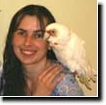The Austerity Diet: What Is It & Why?
Kristen Reeves, Meadowlark Farms Avian Supply, Inc.
Laraine and I consider the Austerity diet to be the beginning of breeding season! Think of Austerity as starting with a clean, blank slate! On this slate we can paint a breeding program that won’t be hindered by extra weight on our birds, hormones out of control, or birds who’ve bonded before we're ready for them to. Austerity is a time to wipe the slate of the previous breeding season clean and begin anew for the next season!
What exactly IS the Austerity diet?
Regardless of what foods and supplements you feed, Gouldians and other Australian finches will pass through 4 very different seasons; Breed/Molt, Juvenile, Resting & Austerity. Each of these seasons performs a function. This article will specifically address Austerity.
The Austerity diet is designed to emulate the severe conditions found in the wild during the dry season and serves a distinct function in both the wild and captivity...
Why do Australians need an Austerity diet?
In the wild, Gouldians and other Australian species are able to find vast amounts of ripening grass seed heads and insects during their breeding season. As those grasses dry out, the seeds begin to dry out as well, lessening the amount of nutrition they contain. When the dry season comes around, most of the dried grass seeds have been consumed. The birds are hard pressed to find foods at all and must travel long distances to find water. They lose weight, drop out of condition, and their systems reset for the next breeding season. The want and need to breed will return with the rich food sources!
Because our captive birds don’t have to worry about the quality or quantity of food they receive, and because they rarely receive the same amount of exercise as birds in the wild, the richer foods of our breed/molt, juvenile and resting diets leave them a bit tubby. Austerity helps to remedy that situation by removing the high protein and carbs they’d receive during those seasons.
But even in captivity, Austerity’s main function is to put a halt to the breeding hormones, drop them out of condition and shrink their reproductive organs - so that once the breeding diet is offered again, they come into condition, pair, and breed well.
When should we run them through Austerity?
Here I typically begin austerity immediately following the end of the resting period and immediately prior to the breeding season - which for my birds is right around September 1st, give or take a week or so.
Austerity lasts approximately 4 weeks. I say "approximately" because on occasion 4 weeks is sometimes too long for birds that were not bred the prior season and don't have all that extra weight, or not long enough for those birds who put on the chub during breeding. I adjust this diet to meet the needs of my birds. A fat bird won't breed well (and may not breed at all), while a thin one won't have enough stores to handle the rigors of breeding.
During this period, the birds receive NO water or food-based supplements, NO greens or wet foods - nothing but plain austere seed, plain water and mineral grit. I continue the grit because in the wild the birds would still pick up bits of sand and grit, and receive minerals from their drinking water. If we are going to emulate what they’d find in the wild, it doesn’t make sense to remove the mineral grit.
No, it's not cruel and no it won't kill them. They won't like it and they may fluff a bit, but if they are genetically and physically sound, they will get through it with nothing more than perhaps a ticked off attitude!
What should an Austerity seed mix look like?
Your seed mix should consist of Japanese millet, rye grass seed, and canary grass – or similar seeds with low protein and carb content. The smaller the kernel within the hull, the better. Tiny kernels force the birds to actually work to get at their meal. The harder they work, the less they’ll eat in a day – effectively imitating the austere findings in the wild.
NO water supplements. NO chitted seed or soft food. NO food-based supplement. NO treats. NO greens. NOTHING but a dry austerity seed mix, plain water & grit.
Again, they may not like you very much at this point and may hang on the cage bars begging for their richer diet, but don't pay any heed! Stick to your guns unless you feel something else is wrong.
No worries, they may not like it, but they’ll survive! ~k





